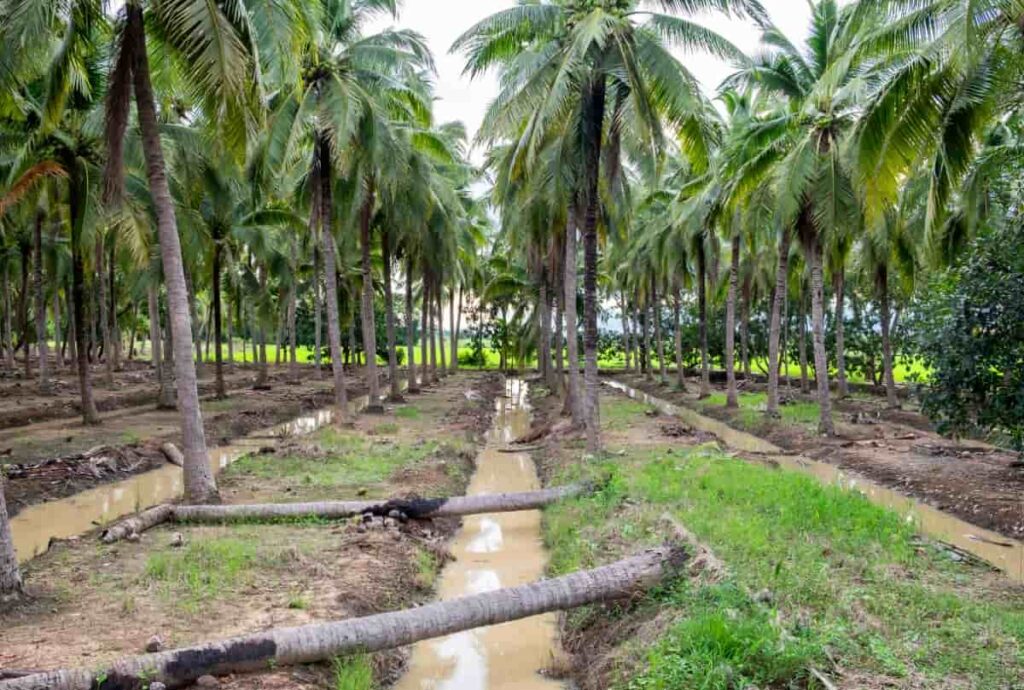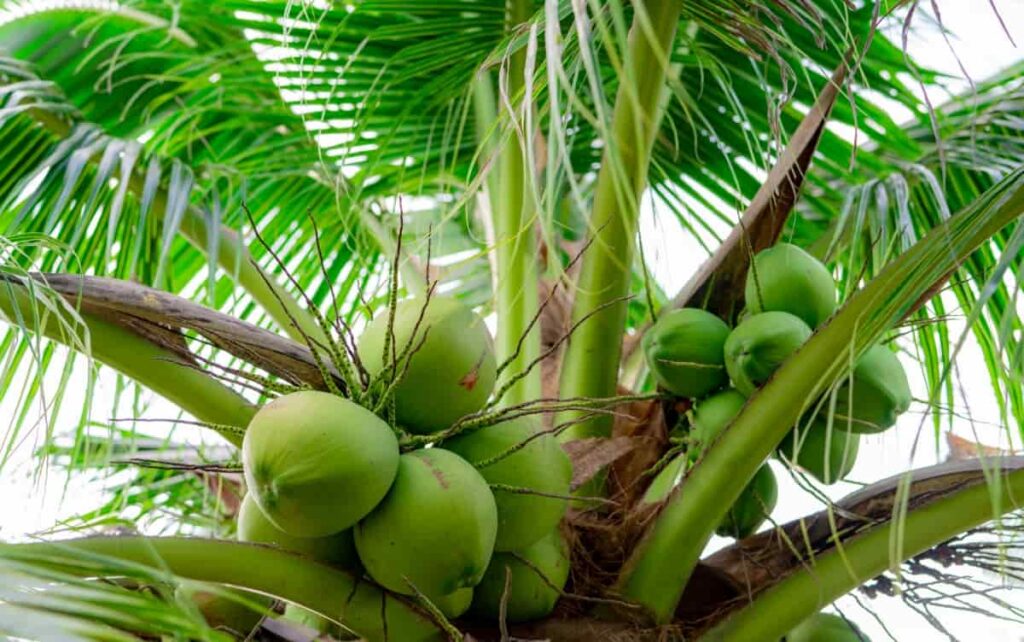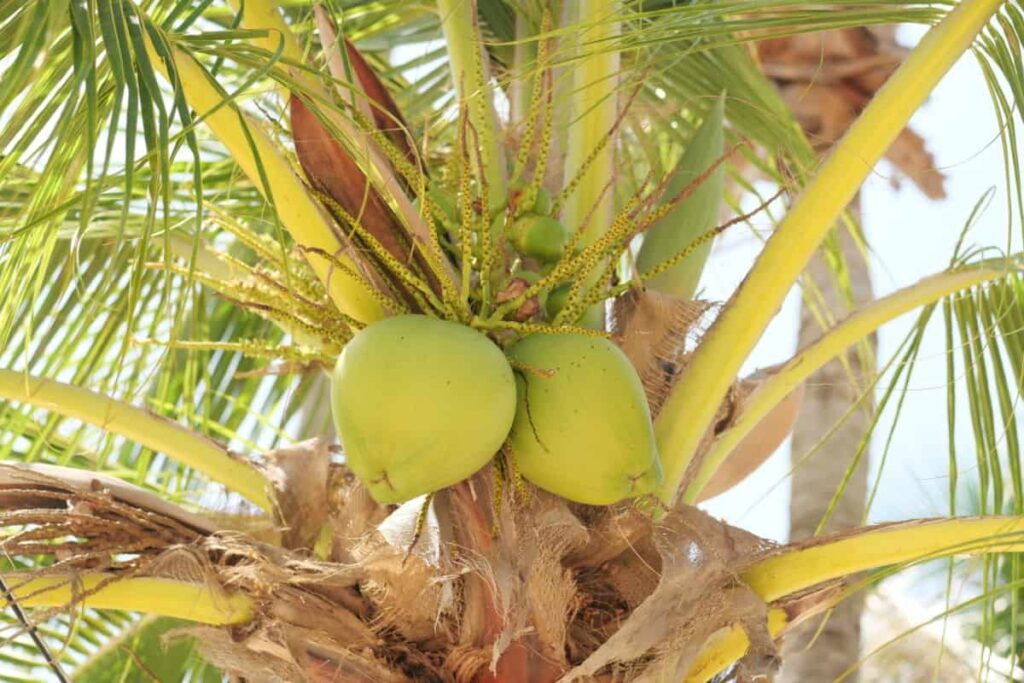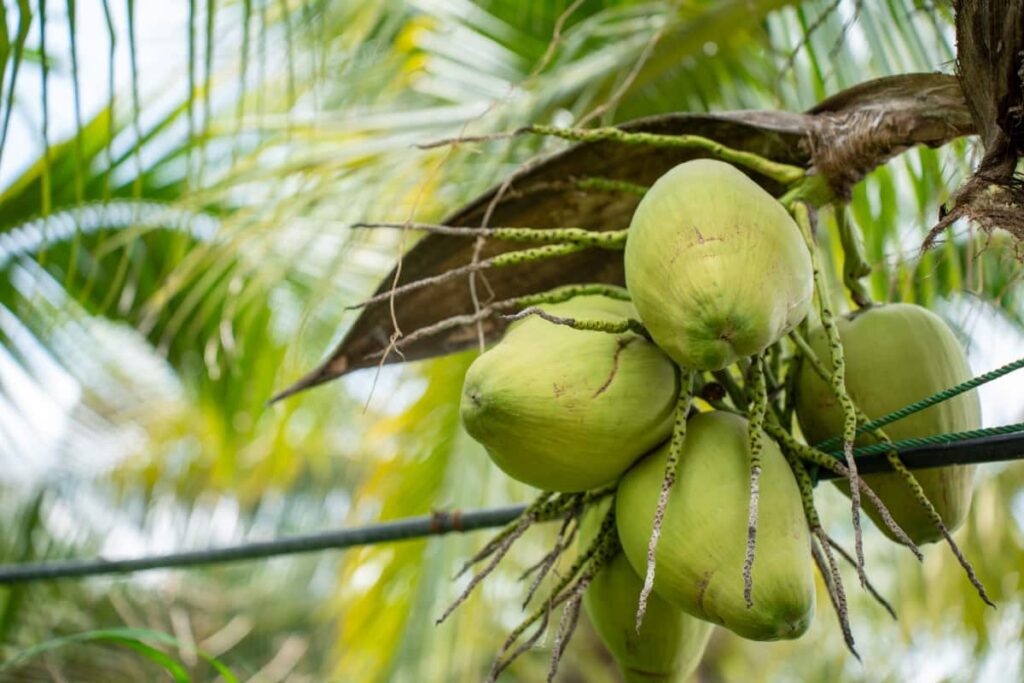Cocos nucifera (L.), commonly called the Coconut palm, is an important member of the family Arecaceae (palm family). It is a versatile and valuable tree that requires specific care to optimize yield. Understanding the irrigation needs of Coconut groves is crucial in maximizing production. By implementing irrigation schedules, farmers can ensure their Coconut trees receive the right amount of water at the right time.

Understanding Coconut Water Requirements
Understanding Coconut trees’ specific water needs is crucial for ensuring a bountiful yield from your grove. Coconut palms require regular watering, especially during dry periods, as they have shallow root systems that need consistent moisture. Insufficient water for the Coconut tree can lead to stunted growth and decreased fruit production.
Monitoring soil moisture levels is essential in determining when and how much to irrigate your Coconut grove. Temperature, humidity, and rainfall patterns all affect the optimal watering schedule for your trees. By providing adequate water at the right times, you can support healthy tree development and promote higher Coconut yields.
Climate Influence on Irrigation Scheduling
Local weather conditions significantly determine how much water Coconut trees require at different times of the year. In regions with hot and dry climates, Coconut trees may need more frequent watering to thrive and produce quality yields. Conversely, in cooler or more humid areas, you might have to adjust your irrigation schedule accordingly to prevent overwatering.
Understanding the specific climate patterns in your area will help you tailor your irrigation practices effectively. By being mindful of temperature fluctuations, rainfall levels, and humidity variations throughout the seasons, you can ensure that your Coconut grove receives the right amount of water it needs to flourish.
Soil Types and Their Water Holding Capacity
Different soil compositions can impact how well they retain moisture, affecting the watering needs of Coconut trees. Sandy soils have lower water retention capabilities, requiring more frequent irrigation to sustain Coconut growth. On the other hand, loamy or clayey soils can hold onto water better, reducing the frequency of watering sessions needed.
In case you missed it: How to Stop Coconut Flower Drop: Proven Remedies and Effective Treatments

Identifying the specific soil type in a Coconut grove allows farmers to tailor their irrigation schedules accordingly. Finding the perfect balance promotes optimal growth and yield in Coconut farming practices.
Implementing Drip Irrigation in Coconut Groves
Implementing drip irrigation in Coconut groves can revolutionize the way water is efficiently managed for optimal Coconut yield. By strategically placing drip lines near the base of each tree, water is delivered directly to the roots, minimizing evaporation and runoff. This method ensures that each Coconut palm receives just the right amount of moisture it needs without wastage. Drip irrigation also helps in preventing weed growth between trees since water is targeted specifically where it’s needed most.
This not only saves time on manual weeding but also reduces competition for nutrients among plants. Additionally, this precise watering technique promotes deeper root growth, making Coconut trees more resilient to drought conditions. The technology behind drip irrigation systems allows farmers to customize watering schedules based on factors like soil type and weather patterns. With this level of control, Coconut growers can fine-tune their irrigation practices to suit their groves’ specific needs and maximize productivity.
Monitoring Soil Moisture for Optimal Watering
By keeping a close eye on the water content in the soil, farmers can ensure that their Coconut groves receive just the right amount of hydration. The effective way to monitor soil moisture levels is to use sensors strategically placed throughout the plantation. These sensors provide real-time data that allows farmers to make informed decisions about when and how much to water their Coconut trees.
By analyzing this data regularly, farmers can prevent both overwatering and underwatering, which are detrimental to Coconut growth and yield. Maintaining optimal soil moisture levels promotes healthy root development and overall tree health.
Seasonal Adjustments in Irrigation Practices
During the hot and dry summer months, you may need to increase watering frequency to meet the heightened water demands of the Coconut trees. Conversely, in cooler and wetter seasons, you might dial back on irrigation to prevent overwatering and root rot.
In case you missed it: 20 Best Dwarf Coconut Varieties: Hybrid High Yielding Coconut Cultivars

Watch weather patterns closely and adjust your watering schedule accordingly. The goal is to provide adequate moisture without drowning the roots or letting them dry out. By making proactive seasonal adjustments, you can optimize water usage and promote healthy Coconut tree growth throughout the year.
Water Conservation Techniques in Coconut Farming
Water conservation is crucial in Coconut farming to ensure sustainable water usage and protect the environment. Implementing techniques like mulching can help retain soil moisture, reducing the need for frequent watering. Drip irrigation systems deliver water to the roots, minimizing wastage through evaporation or runoff.
Another effective method is rainwater harvesting, which involves collecting and storing rainwater for later use during dry periods. This practice conserves water and reduces reliance on external sources. Also, cover crops can improve soil structure and enhance its ability to retain moisture.
Impact of Irrigation Timing on Coconut Yield
Timing is crucial when it comes to irrigating Coconut groves for optimal yield. The timing of irrigation directly affects the growth and development of Coconut trees, ultimately impacting the quantity and quality of Coconut produced. Watering at the right time ensures that the roots have access to sufficient moisture during critical plant growth stages.
This helps prevent stress on the plants, leading to healthier Coconut trees with higher productivity. Irrigating at inappropriate times can result in water waste or inefficient plant water uptake, which can hinder plant growth and overall performance. By applying irrigation schedules based on weather conditions and plant needs, farmers can maximize Coconut yield while conserving water resources.
In case you missed it: Coconut Farming Information Guide

Advanced Tools and Technologies for Irrigation Management
Exploring advanced tools and technologies for irrigation management can revolutionize Coconut farming practices. Soil moisture sensors enable precise monitoring, ensuring optimal water levels in the groves. Automated irrigation systems adjust watering schedules based on real-time data, maximizing efficiency. Innovative drip irrigation systems deliver water directly to the roots, reducing wastage and promoting healthier tree growth. Remote-controlled irrigation platforms enable farmers to manage water remotely, saving time and labor costs.
Integrating drone technology for aerial surveys provides valuable insights into crop health and hydration needs. Irrigation for Coconut groves is crucial to maximizing Coconut yield. It involves providing the right amount of water at the right time to ensure optimal growth and development of Coconut palms. Successful Coconut grove irrigation is key to achieving higher yields and maintaining sustainable farming practices over time.
- Profitable Village Farming Business Ideas in 2024
- High-Yield Aquaculture: Fast-Growing Fish for Farming
- Effective Fish Pond Construction Techniques for Beginners
- Irrigation and Water Management in Pineapple Farming
- Blossom to Harvest: Mastering Flowering and Pollination in Papaya Farming
- Pig Fattening Essentials: From Selection to Sale for Beginners
- Raising Wagyu Cattle: A Complete Guide for Premium Beef Production
- Soil Types and Their Water Holding Capacity
- Optimizing Irrigation Schedules for Coconut Groves for Enhanced Yield
